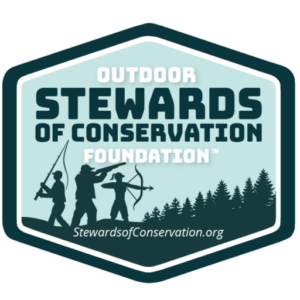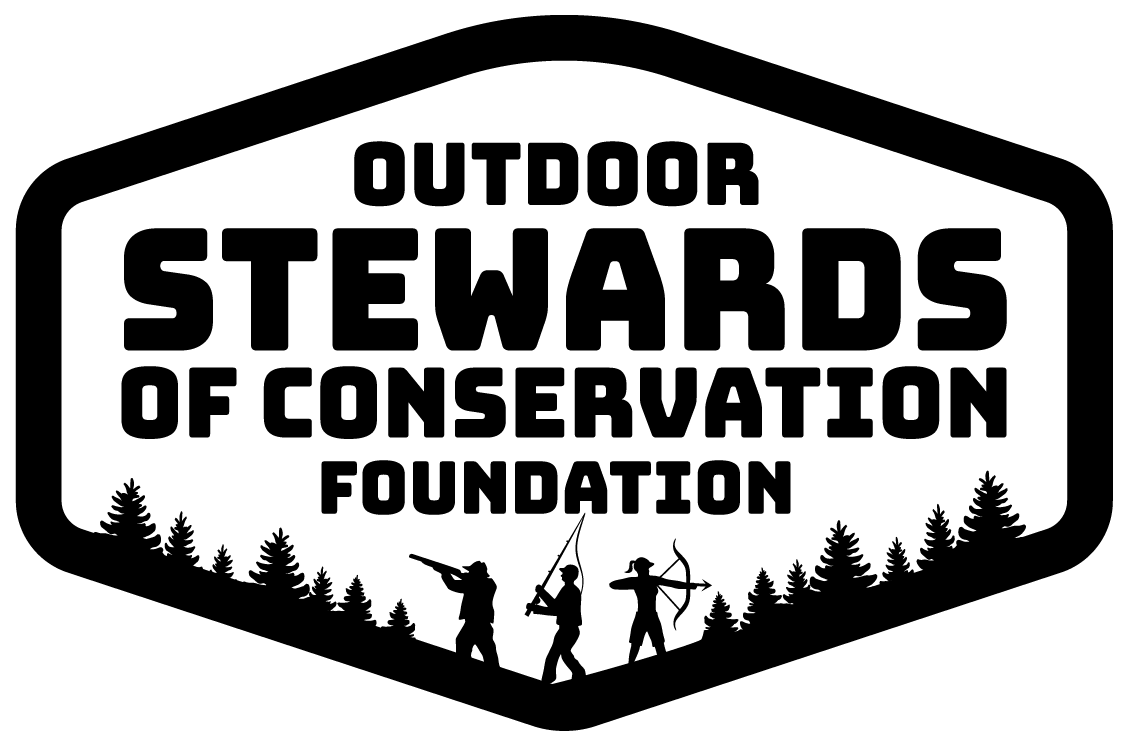


Shareable media promoting conservation from the Outdoor Industry Communication Council (OICC) – see below for more details.
Getting Started in Bowfishing: Equal parts fishing and hunting, bowfishing requires relatively little gear but offers nearly limitless opportunity.
-Andrew McKean
Grab an old hunting bow, a pair of polarized sunglasses, rig a fiberglass arrow with fishing line, and you’re ready to engage with a nearly limitless resource: common carp that are abundant and visible in nearly every waterway this season.
Of all the outdoor recreational opportunities available to anglers and archers across the country, bowfishing offers the most opportunity and the lowest barrier to entry. In most states, you only need a fishing or hunting license and some basic gear to get in the game. Invasive carp are among the most common targets of bowfishers, and in most states there is no limit to the number that archers – or are they fishers? – can take.
If this is an appealing opportunity, then consider how to participate. Longtime western Kentucky bowfisher Will Brantley has what might be considered the pinnacle achievements in bowfishing: a specialized boat rigged with lights in order to bowfish at night, purpose-built bowfishing bows and arrows, and abundant waters nearby in the network of Kentucky Lake, the Cumberland, Tennessee, and Ohio rivers, and associated waterways that are full of common carp, Asian carp, gar, and native buffalo fish.
But Brantley fondly recalls his early sessions as a bowfisher, as a teenager in cut-off jeans wading shallow waters with an old hunting bow in hand.
“Of all the types of hunting — and fishing, too, I suppose — the coolest thing about bowfishing is that it has the lowest barrier to entry. You can take a cheap bow with a coffee can bolted on its riser to hold the string and wade around the shore of a reservoir and shoot a few fish the first time you ever try it. I don’t know any other hunting or fishing outing that requires less gear and offers more opportunity for success.”
Like other hunting and fishing disciplines, you can invest a lot of money in specialized gear in order to maximize your success. But Brantley says it’s not really necessary to get in the game.
“I got started with an old cheap hunting bow,” says Brantley. “After years of bowfishing, I still shoot an old cheap hunting bow. You can get pretty niche [with bowfishing gear], but in my experience, you don’t have to. My most specialized piece of equipment is an AMS reel. At around $100, it’s expensive but it’s probably the best investment bowfishers can make in reliable gear that keeps their line from tangling — but I still shoot my dad’s old PSE bow from the 1990s and a heavy, dumb old fiberglass arrow, and I kill a lot of carp.”
The unifying species for bowfishers is the common carp. In most waters, the invasive species is unregulated, meaning there’s no season or bag limit. When surface water reaches about 55 degrees, they’ll come shallow to spawn, so they’re visible even to bowfishers without a boat. They get big, with most fish in the 5-10-pound range but trophy carp weigh upwards of 30 pounds. And they’re challenging; when they know they’re being pursued, carp are evasive.
And there are lots and lots of carp. In many waterways, they are the most abundant fish species, both by population and biomass.
FISHING? OR HUNTING?
Since the OICC article series considers the various ways wildlife conservation is funded in America, it’s worth asking: is bowfishing hunting? Or is it fishing?
At least as far as federal taxes on bowfishing equipment are concerned, it’s both. The archery equipment — the bow, arrow points, bowstring, sights, rests, peeps, and releases — is taxed at 11 percent, with tax revenues flowing through the Federal Aid in Wildlife Restoration account to benefit terrestrial wildlife managed by state and tribal fish-and-game agencies. The fishing equipment — the bowfishing reels, fishing line, and snap swivels that attach line to arrows — is taxed at 10 percent, with revenues flowing through the Sport Fish Restoration account to agencies’ fisheries and aquatic-habitat programs. Bowfishing shafts, similar to bowhunting shafts, are taxed at about 45 cents per shaft; the specific rate is adjusted annually.
But the physical process of bowfishing is also equal parts hunting and fishing. In order to get into range of fish, you must stalk them, using skills familiar to hunters. Keep your profile low, move slowly and deliberately, know your range, and wait for fish to turn broadside to offer the best shot. Skills familiar to anglers include reading the water in order to find fish, understanding seasonal movement of fish, and then “playing” a fish that’s been impaled by an arrow to land it in a boat or the shore. Species identification is a big part of bowfishing, since native species like buffalo and gar often share water with invasives such as common carp and Asian carp.
Spring and summertime bowfishing will make you a better bowhunter come fall, says Brantley.
“I shoot instinctive, which means I don’t use sights or a release aid,” he says. “But many of my buddies shoot bows that are set up pretty similar to their deer-hunting bows, with 3-pin sights, peep sights on the string, and release aids. Just like target shooting will make a rifle hunter a better shot on game, bowfishing is great practice in understanding how your archery gear works so you’re ready for deer season.”
YOUTH BOWFISHERS
Kids can get in the bowfishing game, too. Brantley’s son shoots a bow with an indeterminate draw length, pulling maybe 20 pounds with his 22-inch draw length.
“He sticks a lot of fish with that light bow,” says Brantley. “The good thing about bowfishing arrows is that they’re heavy, so it doesn’t take a lot of speed to drive them through a fish as long as the point is sharp and you hit them well.”
The haul of fish that bowfishers can land in a good day on the water can be a good dilemma to solve. Some find creative ways to prepare and eat bony carp. Others donate their haul to farmers for fertilizer or return the biomass to the water that produced them.
If you’re new to the sport, you can buy new bowfishing gear from most retailers, but Brantley recommends finding used equipment for the first couple sessions.
“You can generally find old hand-me-down hunting bows, and they work just fine,” he says. “The thing with bowfishing is, especially if you’re shooting from a boat, when there’s lots of action, and you’re shooting a lot of fish, you tend to throw your bow around and grab the line and start pulling fish in. So you’re just beating and banging on your gear all the time, so an old bow is perfect, and maybe even better than a new bow.”
Check your state’s regulations — either fishing or hunting, or both — for license details, season dates, and bowfishing limits. Then get on the water. Carp are available and abundant right now wherever you live. And fish. Or hunt
About the Outdoor Industry Communication Council (OICC):
Formed around the commitment to educate all Americans about the origins of conservation funding in America, the Outdoor Industry Communication Council (OICC) is managed by Outdoor Stewards of Conservation Foundation (OSCF) and Wildlife Management Institute (WMI). OICC works with outdoor writers such as Andrew McKean, to develop informative content that is available to all outdoor organizations and media at no cost. A primary goal of the OICC is to better inform and promote the positive contributions that wildlife agencies, industry manufacturers, NGO’s and end users such as hunters, anglers, trappers and target shooters make to conservation. Outdoor organizations interested in conservation are welcome to use any OICC content to expand the reach of messages created by the OICC. To become a member of the Outdoor Industry Communication Council, contact Jim Curcuruto of OSCF (203) 450-7202 jim@stewardsofconservation.org or Jon Gassett of WMI at (502) 330-9025 jgassett@wildlifemgt.org. There are no costs involved to become a member of the OICC. Members may utilize OICC materials as they see fit with no restrictions. For additional information visit https://www.outdoorstewards.org/outdoor-industry-communication-council-oicc/
This project is funded by the Multistate Conservation Grant Program (F23AP00404), a program supported with funds from the Wildlife and Sport Fish Restoration Program and jointly managed by the Association of Fish and Wildlife Agencies and the U.S. Fish and Wildlife Service.
